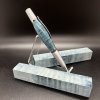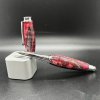I've just recently got a setup for doing stabilization. I got a 6x16 vacuum chamber from TurnTex, and I use their Cactus Juice (CJ) as well. For the vacuum I got a Robinair single stage off amazon. It was a model that TurnTex recommends. Curtis Seebeck, the owner of TurnTex has
excellent customer support. He's very active on the stabilizing facebook groups I'm on, but is also very responsive to emails/calls if facebook isn't your thing. He also has some documentation resources on his website that answers a lot of questions.
One warning,
@Mike Davis - Curtis says to avoid using any chamber that has an acrylic lid like the degassing chamber you linked. The reason being is that cactus juice will interact with the acrylic lid and weaken it, leading to cracks and failures. If you want that style of chamber, make sure it has a glass lid. I've seen several failures due to this in my FB groups.
One other point that Turntex makes is that stabilizing oily woods can be very difficult. The reason being is that the oils will get drawn out during vacuum, and will contaminate the CJ so it doesn't cure properly.
Here's my process. I'm mainly doing small turning blanks at this point (and experimenting with dyeing)
- Dry wood to as close to 0% moisture content. I recently bought a used Laboratory Oven to do this safely. Many people use toaster ovens, but just be careful - Fire Hazard! I bake the wood at 220F until it stops losing weight.
- After drying, I put the wood in a plastic bag to cool down. You do not want to put the wood in CJ while it's hot. CJ cures via heat, so putting hot wood in it will ruin your piece.
- Submerse the wood with CJ in the vacuum chamber and run the vacuum pump. You're going to run it until the air bubbles stop coming out of the wood (this is where TurnTex's chambers are helpful, since they are transparent on the sides rather than just the top). The time for this can take at least a few hours and depends on how big/thick the wood is. The bigger it is, the more time. It is not uncommon for people to leave their pump running for days.
- After there are no bubbles, release the vacuum but keep the wood in the chamber and let it soak. The rule of thumb is that you let it soak twice as long as you had it under vacuum.
- After soaking, time to heat cure. I wrap it in aluminum foil to contain the mess. Put it in an oven at 190-200F. For a pen blank, the bake time is 1-1.5 hours. Curtis says that the internal temperature of the blank needs to get to 190-200 for 10 minutes for the CJ to cure, so thicker pieces are going to take longer.
TurnTex's guide to using cactus juice:
Using Cactus Juice Stabilizing Resin
Here's two pens I did using dyed CJ to stabilize some curly maple as an example. The red pen is a double dye with blue and red.


Info above is what I've learned so far - with the disclaimer that I just started! There may be some on here that are more experience than I with this process, but I've gotten good results so far.


